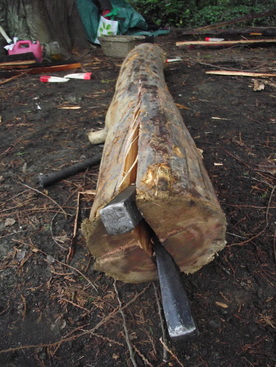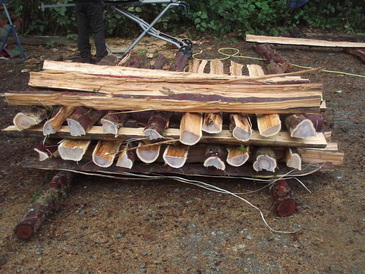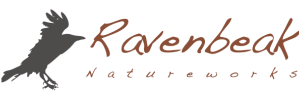Harvesting the YewThe last couple of weeks have been very busy in the shop dealing with a big pile of yew logs and getting them ready to dry and season safely. There is a lot of discussion out there as how best to process logs into staves and I would like to take this opportunity to share my experience and findings. I have found that the best and safest way to produce high quality staves for self bows is to start with green standing trees. The trees need to be felled and cut to length and ideally carried out of the bush gently to minimize damage to the bark and sapwood Splitting Out a Stave I have tried different ways of cutting up a whole log, but after all these years my preferred method is still good old fashioned splitting with a sledge and wedges, as follows.
That is how it is supposed to go, but often things don't go quite as planned and there are many things along the way that can affect the final product. TwistThe first major issue we deal with when processing wood is twist. Pacific yew is very prone to twisting, it seems to just be a part of the species. Often you are able to see the twist in the tree while standing and they are wound up just like barber poles. Other times the twist is very gentle and you can just make it out in the bark pattern if you look closely. That would seem simple enough, but once you start splitting the logs up you can have ones that look twisted to split perfectly straight and you can have others that look straight to split spiraled. You never really do know until they are cracked open. We can still build bows out of twisted wood, but we need to spend more care and attention to untwist the bow during the build. I have found it best to try and limit the amount of twisted wood right from the get go. Drying ChecksThe second major issue we commonly come across is drying checks. When wood dries it shrinks and as wood shrinks it can not shrink uniformly and so somewhere must crack and give to allow the shape to change. This is why we make sure to seal both ends of every stave we process. I have found that the flat surface of end grain is a very difficult surface for wood to maintain and it almost wants to check (fancy bowyers word for crack). I used to use wood glue to seal end grain, but now have switched to a wax based product. I have also found that any place on a stave where the bark has been knocked off is also sensitive to drying too quick and cracking, so I now seal any area of the sapwood where the bark is banged up Ring SeparationAnother issue that we come across often is a ring separation. For some reason two years of the tree seem to have no adhesion between them and once split into staves they will separate no matter what we do. I don't know if it is from flood, drought, wind or what but this is a relatively common problem when working in yew staves. This is not always a bad thing, depending on where the separation occurs we can sometimes get two "piggy back" staves. One backed with the outer sapwood and one all heartwood. I have made some really nice bows from these inner splits as the back of the bow is already down to one continuous growth ring. The problem is that we have no control over the thickness of the staves and sometimes they are too thin to produce heavy poundage bows. Animal ActivityAnimal activities have proven to affect quite a number of the staves as well.
KnotsLastly we need to talk about knots. Pacific yew is a knotty gnarly tree. The clean faces for staves seem to be the exception not the norm, and the percentage of trees which can actually yield useful staves is very low. It is quite common to have one side of the tree clean but the other side covered in large and small knots. We all know that bows can be made with knots in them, but we still try to keep the number of knots low. Even the nicest staves usually have a few pin knots here or there. On to the Shop After all that we are left with our collection of staves and now the bow making process really begins. A few years ago I purchased a nice big bandsaw (Thanks Jenna!) and this really increased the number of staves I was able to produce. I still prefer to split my logs first to show the twist, but it now allows me to start slicing staves out of the big splits. Where as before it was too risky to split down any further, as I definitely didn't want to waste a good stave by getting greedy. I also prefer to saw the smaller logs as I found it risky to split logs smaller than 4 inches as the chance of the split running off the side was too great. I hope this will shed some light on to some of what goes on before the staves arrive at the workshop, or at least help to appreciate the rarity and preciousness of a nice yew stave. Cheers, Jamie MacDonald
10 Comments
Bryant Moodie
12/15/2015 11:42:12 pm
Hi Jamie
Reply
12/17/2015 12:01:43 pm
Good to hear from you Bryant. Glad that you're getting some shooting in, but sure sounds hot! It's a very wet December on the coast. Making up for the dry summer. Happy Holidays to you and Marilyn.
Reply
12/16/2015 12:54:14 am
Good write-up, Jamie. A great insight to a part of the process most people never see.
Reply
1/19/2016 07:21:48 am
Thanks Mont. Our bow prices vary from $800cad (about 550 usd right now) for a yew/bamboo laminate to $1400 for a self warbow. A self yew bow under 70lbs. is $950, $1100 custom.
Reply
Logan Harris
1/22/2021 12:33:53 am
Hello there!
Reply
Jamie MacDonald
1/25/2021 10:14:12 pm
Hey Logan,
Reply
Alistair
11/14/2021 07:36:45 am
I've heard that yew can have issues in cold weather, going into winter I was wondering how true this is. I'm a hunter and do not usually let cold weather stop me from sitting for a few hours.
Reply
12/4/2023 11:33:46 am
What a fascinating journey from Pacific Yew to bow stave! Jamie, your detailed account offers a real appreciation for the meticulous care and knowledge required in this craft. It's enlightening to understand the challenges, from handling twists and drying checks to wildlife impacts, that influence the final quality of a bow stave. Your commitment to preserving traditional methods while adapting to new techniques is truly admirable. This post not only educates but deepens our respect for the art of bow making. Thanks for sharing your insights and passion!
Reply
Leave a Reply. |
Categories
All
Archives
April 2017
|
|
|

 RSS Feed
RSS Feed

